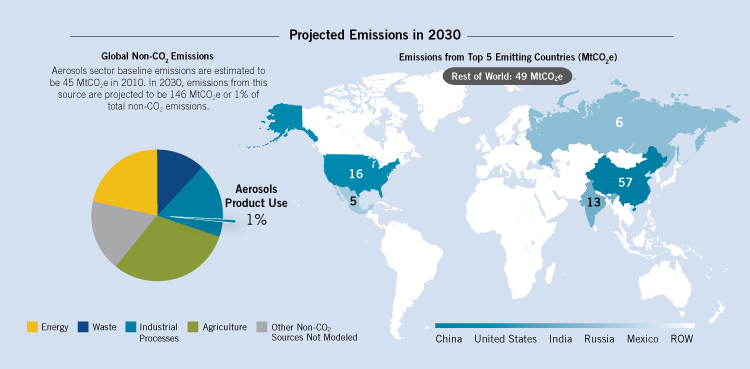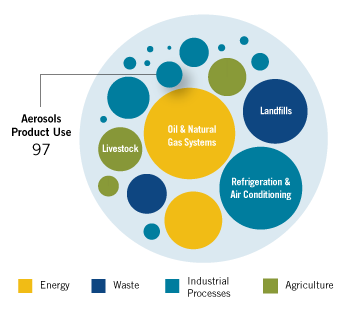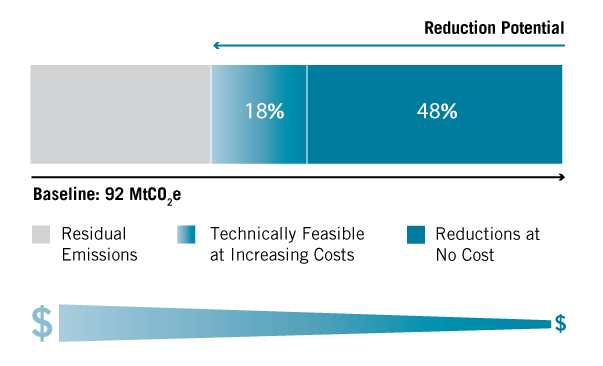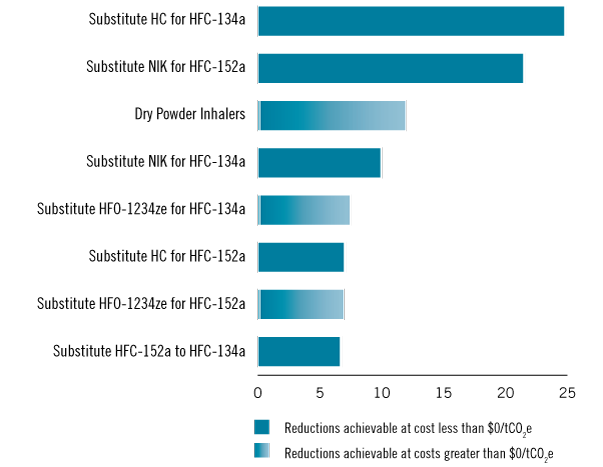Global Mitigation of Non-CO2 Greenhouse Gases: Aerosols
Key Points
- Global baseline emissions in 2010 for aerosols were estimated at 45 million metric tons of carbon dioxide equivalent (MtCO2e) and projected to climb to 100 MtCO2e and 146 MtCO2e by 2020 and 2030, respectively.
- Five abatement measures were considered for the aerosols sector, including transitioning away from HFC use to lower GWP propellants and producing alternative non-aerosol consumer products, such as a stick or roller.
- Relatively low cost abatement measures (≤ $5/tCO2e ) are projected to be capable of mitigating 53% of the sector emissions in 2030.
Sector Description
Aerosol propellant formulations containing hydrofluorocarbons (HFCs) are present in a wide variety of consumer products—such as hairsprays, deodorants, and cleaning supplies—as well as technical and medical aerosols. Baseline HFC emissions from aerosols were estimated at 45 MtCO2e in 2010 and are expected to increase to 146 MtCO2e by 2030. This rapid growth is primarily driven by the increased use of aerosols containing HFCs in developing countries.
 View or download the full-size image here.(125 K, PNG)
View or download the full-size image here.(125 K, PNG)
Emissions Reduction Potential
Assuming full implementation of current technology, emissions in the aerosols product use sector could be reduced by up to 97 MtCO2e in 2030. This accounts for 2% of the 4,615 MtCO2e in global reduction potential in 2030.
 View or download the full-size image here.(101 K, PNG)
View or download the full-size image here.(101 K, PNG)
Abatement Potential
The global abatement potential from aerosols containing HFCs is estimated to be 96.7 MtCO2e—66% of BAU emissions from this sector and 5% of total annual emissions from all sectors that use ozone-depleting substance substitutes in 2030. At $5 per tCO2e, the abatement potential is estimated to be 53.4% of baseline emissions, or 77.8 MtCO2e. Furthermore, the abatement potential at prices ≤ $0 per tCO2e is forecasted to be 70 MtCO2e (48.2% of BAU emissions) for 2030.
 It would be cost-effective to reduce emissions by 48%, compared to the baseline, in 2030. An additional 18% reduction is available using technologies with increasingly higher costs.
It would be cost-effective to reduce emissions by 48%, compared to the baseline, in 2030. An additional 18% reduction is available using technologies with increasingly higher costs.
View or download the full-size image here.(36 K, PNG)
Abatement Measures
Abatement options available to reduce emissions for consumer aerosol products include transitioning to replacement propellants with lower GWPs—HCs, HFO-1234ze, and HFC-152a (where HFC-134a is used)—and converting to a not-in-kind (NIK) alternative, such as sticks, rollers, or finger/trigger pumps.
 Emissions reductions by technology in 2030 at $0/tCO2e and at higher prices.
Emissions reductions by technology in 2030 at $0/tCO2e and at higher prices.
View or download the full-size image here.(41 K, PNG)
